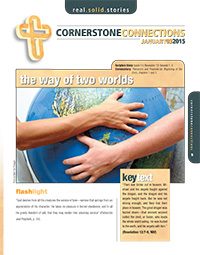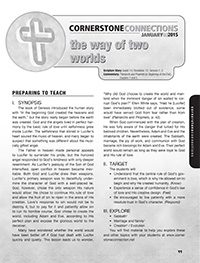The standard Youth Sabbath School materials for the topic “The Way of Two Worlds” contains a Student Lesson and a Teacher’s Guide. In addition to these materials provided by the General Conference Sabbath School Department, the North American Division Youth Department is providing supplemental materials you may choose to add to this lesson. Think in terms of your specific setting and the young people at your Youth Sabbath School. As you seek to involve them in the study and application of the Bible for this week, prayerfully pick and choose the components that will form the Youth Sabbath School for your young people. Be sensitive to the Holy Spirit as you make your plan, and then continue to be sensitive for the Holy Spirit to guide you during the Sabbath School.
Overview
God created the perfect world, but a second option vies for our choice.
Read the Student Lesson as well as the Teacher’s Guide. This may provide everything you need to teach the Youth Sabbath School lesson.



An icebreaker or something to get people focused as you begin.
Invite those present to come stand in the middle of the front of the room so there is space to move to the right or to the left. Explain that you are going to speak two words and then participants must move to one side of the room or the other, depending on which word they think better describes the way of God’s World.
Explain that the topic this week is “The Way of Two Worlds” and we’re going to start by identifying some of the characteristics of God’s world, at least as we understand it right now.
After each word pair, the leader can ask for explanations or simply bring people back to the middle and then choose from the next two word-pairs. Feel free to adjust these or create your own word-pairs. If you identify more with the first word, move to the left; if you identify more with the second word, move to the right. When you’re finished with a word-pair, have everyone return to the middle for the next word-pair.
Is God’s world better described as:
Have an arm-wrestling contest. Most people know how to do this. If you don’t, just Google it or type “Arm Wrestling” on YouTube. Have people pair up to do this. If you have more than two people, you can keep going until you have a champion. The main purpose of this isn’t to make one person a champion, but to raise the question of whether or not the conflict between good and evil (Christ and Satan) we see in our world is just like an arm wrestling competition, or if there is more to it than that. Is Jesus stronger than Satan? Is Satan stronger than Jesus? Do we have to wait and see?
TRANSITION: As we consider “The Way of Two Worlds” today, think in terms of your current understanding as well as how your understanding may change because of what we study in the Bible or because of what God communicates to us during this Sabbath School lesson.

A short video clip and an idea for you to create your own video on this week’s topic, plus a few questions to follow up with discussion.
Create a video clip that shows evidence of God’s world. Create a second video clip that shows evidence contrary to God’s world—an alternate world that is also present in our lives. Ask someone in advance to create follow up questions based on these video clips.
Or you can use the following YouTube video clip “Dust & Stars” (just under 3 minutes) and the follow up questions provided (or create your own questions for “Dust & Stars”: www.ibelievebible.com/dust-stars/
FOLLOW-UP QUESTIONS
1. Based on your life so far, is there more evidence that God:
A. Exists
B. Doesn’t exist
2. Based on evidence beyond your life (other people, history, science, Scripture, relationships, circumstances, etc.), what makes you think God:
A. Exists
B. Doesn’t exist
3. What is a good description of God?
Upon what do you base this?
4. How do you explain the existence of both good and evil on earth?
Which is stronger?
Does it ever change?
5. Is God visible or invisible?
How can a person know God?
How do you know God?

There are options!
5. Here is an original song, written specifically for this week’s Youth Sabbath School lesson “The Way of Two Worlds.” You can download the lyrics, download the music, and download the video to learn and teach this song, “Choose You Lord,” in your Youth Sabbath School. Learning new songs usually takes several times before people catch on. You may want to have a few get familiar with it in advance so they can lead the rest of the group.

Another approach to the same topic as the Teacher’s Guide, but just a different way of looking at it. Expect activities to illustrate the topic, followed by some questions.
Hand out a blank sheet of paper and ask the youth to number from 1-7. Then have them list what God created each day of creation week (days 1-7).
After having them try it from memory, take turns reading Genesis 1:1–2:3. Make any corrections needed to the seven days of creation on their sheets of paper. But also go beyond the simple information and ask what other elements in the story of creation caught the attention of those reading/listening.
For example:
Consider the seven days of creation in a series of 3-3-1: 3 days, 3 more days, and then one final day. Use three poster boards or giant post-it sheets and write “Day 1” on the first sheet; “Day 2” on the second sheet; and “Day 3” on the third sheet. Ask a youth to write on each day what God created for that day (Day 1=light; Day 2=water and air separated; Day 3=dry land and vegetation).
Point out that in Bible times, the number three symbolizes God. God started with a series of three for creating this world. Then God did another series of three by filling the three days with more on the second round of three than the first three. In other words, God fills what he creates. Invite the youth to take the construction paper and cut out and then paste on the various days elements that God filled for each of the first three days. For example, God created light on day 1, the first day of the first set of three days. On the first day of the second set of three days, (that would be day 4) God filled the light with sun, moon, and stars. Here’s the enlargement that God filled the earth with during creation week:
The description of God’s creation of this world shows us that God is creative, active, and powerful. However, it also shows that God’s tendency is to always do more and to fill things to their fullest point.
Humans who prepare to bring a child into the world do things on a smaller scale. Of course, we are made in God’s image, so we would do the same types of things. New dads and moms prepare a place for their coming baby. Typically, they decorate a room with stuffed animals, lots of colors, a mobile of fake, flying birds, soft areas, lights of various intensity.
They prepare for a new born. God did the same thing in the beginning. The difference with God is that he works on a much, much bigger scale, and a much larger budget! He is God! This stands in such contrast to those who try to grab as much as they can for themselves, even storing/hoarding it for themselves rather than sharing or giving it away to others. It’s so contrary to the way God works. Fear and selfishness motivate people to cling to stuff rather than to give generously because they trust or know that God always provides what is needed.
On this first Sabbath of a new year, we often find it hard to “start new,” especially when it’s just days on a calendar. For many teens, their “year” begins with the start of a school year or the start of the summer vacation; not the end of Christmas vacation. However, for some, this has marked a transition point. Maybe it’s not “creation” from nothing, but a “re-creation” from what was last year.
There’s still another poster/post-it sheet. Mark “Day 7: Sabbath” on it and put it after the other three posters/post-it sheets. Explain, “After God took three days to create the world and then three more days to fill what he had already created, God had everything right where he wanted it. With a full world, he crowned his creation with the very first Sabbath. With a full earth, the first man and woman spent their first full day enjoying the amazing earth God had created, each other, and the God who made it all. Humans were made to worship God; that’s how we’re hard-wired. This is how God made this planet. And we still get to do this each week. Sabbath is still present for us to worship our Creator, to revel in his creation, and to connect with the people he made for us to be in relationship with. Happy Sabbath! Those who don’t worship God end up worshiping others, superstars, themselves, their work, money, or even things considered positive like family, reputation, church, and friends. Anything that takes the place of God as our object of worship is simply an idol that replaces God. Each Sabbath we have the opportunity to get on track with our worship by directing it to the God who created us, saves us, and promised to return for us! Happy Sabbath!
Don’t be an evolutionist and expect Sabbath to just somehow evolve. God didn’t do it that way. God started on day one and spent a full six days to create the world and fill it full. God spent six days preparing for the seventh day. That’s a model for us. If we just collapse into Sabbath instead of preparing for it all week, the Sabbath will lack the fullness God intended for us to experience with him, with each other, and with all of creation.
Read Revelation 12:1-17. Explain that this portion of the Bible is highly symbolic. Ask the youth to write on a piece of paper the various symbols in these 17 verses.
Have them work in pairs to come up with as many symbols named as they can find. Then have them note which ones are explained and which ones are not explained. Let this lead to a discussion about what is clearly revealed and what isn’t as clearly revealed in this chapter of Revelation.
Here are some of the symbols in Revelation 12:
It might be difficult and too much to delve into this loaded chapter in the middle of Revelation as just one part of Sabbath School. It may lead to additional study. Invite each youth to pick out one symbol that caught their attention. Some of the symbols in Revelation can be better understood by comparing them with other parts of the Bible—both the Old Testament and the New Testament. For example, the name “Michael” appears in Daniel
10:13 and 12:1 as the warrior form of Jesus (see also Jude 1:9).
Another unique symbol of this enormous dragon with 7 heads and 10 horns seems to be a composite of the different beasts Daniel saw in vision as recorded in Daniel 7 (1-head lion, 1-head bear, 4-heads leopard, 1-head terrifying beast with 10 horns = 7 heads and 10 horns).
For the purposes of this particular study of “The Way of Two Worlds” point out that the war in heaven took place after Christ returned to heaven following His death and resurrection on earth. While God created the world and gave it to Adam and Even (see Genesis 1–2), they lost it to Satan in the Garden of Eden. When Jesus came to earth, He took this earth back from Satan (see John 12:31 and 16:11). Most Christians think of Satan being cast out of heaven before the creation of this world. Indeed, Satan was in the Garden of Eden where he tempted and overcame Adam and Eve and became the temporary prince of this 9 world. But he still had access to heaven (see Job 1:6–12 and Zechariah 3:1–5) until Christ returned and cast him out of heaven. The reasons most Christians think all of this happened before God created the world is because of John Milton’s amazing, epic 12-volume poem called Paradise Lost (1669) in which he described it this way. But just read Revelation 12:13 and you’ll see that when the dragon was hurled to the earth, he pursued the woman who had given birth to the male child (the birth of Jesus). So Satan’s expulsion from heaven
happened after the time Christ came to earth. What difference does this make?
All heaven has been through hell because of us! Satan was in heaven accusing God’s people for thousands of years! But Satan no longer has access there. Heaven has become heaven again. And Satan’s world/universe is getting smaller and smaller. But it doesn’t seem that way to us because Satan is now limited to one small part of the universe—earth! And he’s enraged because he knows his time is short and Christ will be here to end it all for him. Until that time, we can expect to see the dragon’s rage all over this earth.
Create a timeline that shows the creation of this earth; the fall of Adam and Eve in the Garden of Eden; the birth, death, and resurrection of Jesus; Satan’s expulsion from heaven; the second coming of Jesus; and where you are on the timeline now.

Read Isaiah 14:12-15. This passage is directed as a prophecy to the king of Babylon (see verse 4), but it also includes the anti-God and anti-God’s people power that has been present during most of this earth’s history. King Nebuchadnezzar of Babylon certainly had to face pride and experienced being brought down from his high perch (see Daniel 4—the entire chapter, but especially verses 17, 27-33). His grandson, Belshazzar, lost the kingdom of Babylon because of his ego (see Daniel 5—the entire chapter, but especially verses 1-4, 22-28, 30).
This same thing plays out is many different ways.
We can make a circle by putting blue painter’s tape on the floor to mark off an area we will call “the hill.” We’re going to play “King of the Hill” by placing one person inside the circle. That person will try to stay inside the circle by pushing away anyone else who tries to take this spot. Everyone else will try to remove the person inside the circle and take that place for themselves. There really aren’t very many rules. The goal is to be the “King of the Hill” by occupying that position by yourself. (Pick one person to start in the middle, make sure the area is free of other objects, and let the fun, ego, and savagery begin. Monitor as needed.)
After the activity, sit in a group and ask the following questions (or questions of your own choosing).

Let this spark your ideas to move from talk to action by living out the lesson in practical ways in your life this week.
A. Prepare all week for Sabbath rather than collapsing into it. By making Sabbath the focal point for your week, everything will point toward it rather than using this day of worship to simply be a catch-up or catch-all day. Plan for it like a birthday party—it is the birthday of our world! What plans will you make for the worship celebration next Sabbath?
B. Consider some of the decisions you’re likely to face this week. In the war of two worlds (God’s world and Satan’s world) that both seem quite real on this planet right now, which choices would match God’s world and which choices would match Satan’s world? Are there choices in which you are uncertain? What will your prayer be in those situations, and whom could you contact for Godly input for your decision?
C. Consider a place in your life where you are tempted to play your own version of “King of the Hill.” Are you able to release your need to prove to others that you’re the greatest by accepting God’s approval of you, or do you need that affirmation from other people? Do others give it to you when you’re on top of everyone else? Replace your need to be above others by taking your talent(s) and using them to serve others rather than lording over others. Ask a friend to give you feedback and support as you seek to serve others.

If Sabbath School is just for us, we will spiritually die. We must share what we’ve been given. This can be done locally and/or globally. We’ll suggest several options over 3-4 weeks on reaching out.
With the topic of “The Way of Two Worlds” there are two worlds you can face. The first is the world in which you live every day. The second is the
world that millions and even billions of people you age live in every day—a world in which they aren’t even sure where their next meal will come from, if they get any food. That’s hard for most of us to comprehend.
The long-term impact is greater, but you can do something about one more meal for someone living far away, or even someone living near you.
For the person/people living far away, here’s a website where you can make a contribution that will make an immediate difference in providing food for someone who is hungry right now.
https://giftcatalog.adra.org/#/
Several African countries are facing unprecedented hunger. Millions don’t know when their next meal will come, and children are hit especially hard. When you help provide school lunches to children, it’s more than filling tummies. These meals give families incentive to keep kids in school during a difficult time.
For something closer to where you live, contact your local community services organization (at your church or in your community) and ask where you can provide a bag of groceries for someone who needs food right now. If that doesn’t provide the information you need, ask your pastor, other pastors in your community, or the police, or look up your local food bank online.

This bonus is just for the youth leader—a quick tip and an illustration to enhance your youth leadership. You may already know this, or you may learn it through trial and error, or maybe you just need a reminder of something you already know. Here’s a way to get it with a quick infusion.
A BIT MORE
It’s easy for youth leaders to revert to their favorite topic or “hobby horse.” Following a curriculum will take you (and the youth) into areas you might not have considered. This doesn’t mean you can’t make changes or adapt to something pressing or current at any given time. The way you do things will be your individual stamp, but it’s best to follow a curriculum that meets your young people. It also provides continuity when if leadership changes from week to week, and a purpose and direction for your group.
